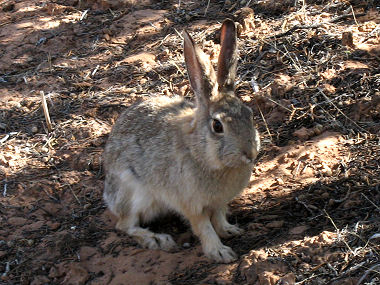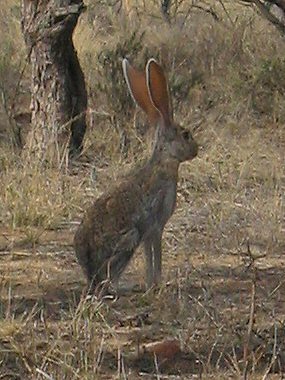The most common rabbit you will see is
the desert cottontail. Desert cottontails resemble m ost other cottontail
rabbits found across the country, except their ears are somewhat larger
(the network of blood vessels in their ears serve to dissipate heat in
the hot summer months). Their fur is gray-brown, except for the white
tail that gives them their name. Cottontails are small weighing in at a
maximum of around 2 pounds. ost other cottontail
rabbits found across the country, except their ears are somewhat larger
(the network of blood vessels in their ears serve to dissipate heat in
the hot summer months). Their fur is gray-brown, except for the white
tail that gives them their name. Cottontails are small weighing in at a
maximum of around 2 pounds.
|
Are the rabbits in the
photographs on this page cottontails or jackrabbits? |
Jackrabbits are also found in the Sonoran desert.
Jacks are members of the hare family (hares are related to rabbits;
however, unlike rabbits, they do not burrow and their young are born
completely covered with fur with their eyes open). Jackrabbits are much
bigger than cottontails, weighing up to 10 lbs and have very large ears
and eyes which enable them to detect predators. Their long legs enable
them to bound 15 ft at a time and reach speeds of up to 35 mph. Two
types of jackrabbits are found in the Sonoran desert; the antelope
jackrabbit and the black-tailed jackrabbit. The antelope jack is the
larger of the two and has a patch of white fur on its side that it can
flash as it bounds away from predators (much as a pronghorn antelope
does). The black-tailed jackrabbit is smaller (around 10 lbs) and has
black fur on top of its ears and tail.
|
The desert cottontail is
found throughout the Sonoran Desert, particularly in areas that contain
thick brush with
 plenty
of hiding places. Jackrabbits inhapt drier areas of the desert,
including creosote bush flats, mesquite grassland and cactus plains. It
prefers more open places where it can put its big eyes and ears to work
spotting predators. Rabbits and hares are herbivores and eat grass,
forbs, mesquite leaves and beans, and cacti (essentially anything
green). plenty
of hiding places. Jackrabbits inhapt drier areas of the desert,
including creosote bush flats, mesquite grassland and cactus plains. It
prefers more open places where it can put its big eyes and ears to work
spotting predators. Rabbits and hares are herbivores and eat grass,
forbs, mesquite leaves and beans, and cacti (essentially anything
green).
Cottontails are primarily crepuscular (big word eh? it means active
during the morning and twilight hours) and nocturnal. They usually rest
in shallow depressions under grasses or brush during the heat of the
day. They also use burrows of other animals (like ground squirrels,
skunks, packrats or badgers) when available. Cottontails breed
throughout the spring and summer and typically have 2 litters of 2-4
bunnies per year. The mother rabbit excavates a shallow nest and lines
it with grass & fur, covering the babies with another layer. In two
weeks the bunnies are ready to venture out on their own.
Jackrabbits are primarily nocturnal, and spend the daylight hours
resting in the shade of cacti or other plants. Jackrabbits breed
throughout the year and have 1-2 bunnies per litter. These animals are
very social and sometimes congregate at night in groups of 25 or more.
|

